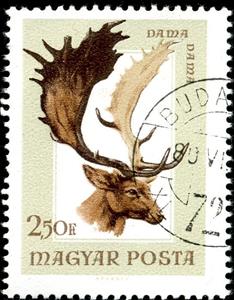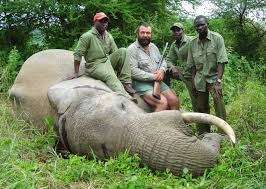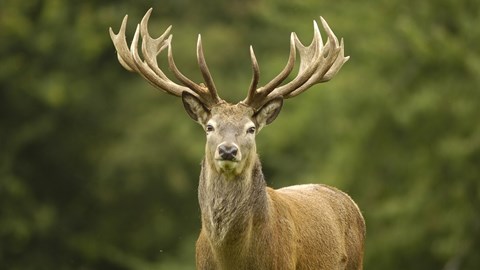Stamp: Fallow Deer (Dama dama) (Hungary 1966)
Fallow Deer (Dama dama) (Hungary 1966)
04 July (Hungary ) within release Hunting goes into circulation Stamp Fallow Deer (Dama dama) face value 2.50 Hungarian forint
| Stamp Fallow Deer (Dama dama) in catalogues | |
|---|---|
| Michel: | Mi:HU 2260A |
Stamp is vertical format.
Also in the issue Hunting:
- Stamp - Red Deer (Cervus elaphus) face value 1.50;
- Stamp - Roe Deer (Capreolus capreolus) face value 80;
- Stamp - Fallow Deer (Dama dama) face value 2.50;
- Se-tenant - Fallow Deer (Dama dama) face value 250;
- Stamp - Wild Boar (Sus scrofa) face value 60;
- Stamp - Mouflon (Ovis orientalis orientalis) face value 300;
- Se-tenant - Roe Deer (Capreolus capreolus) face value 80;
- Stamp - Wildcat (Felis silvestris) face value 70;
- Stamp - Red Fox (Vulpes vulpes) face value 20;
- Se-tenant - Red Deer (Cervus elaphus) face value 150;
Stamp Fallow Deer (Dama dama) it reflects the thematic directions:
Mammals are any vertebrates within the class Mammalia (/məˈmeɪli.ə/ from Latin mamma "breast"), a clade of endothermic amniotes distinguished from reptiles (including birds) by the possession of a neocortex (a region of the brain), hair, three middle ear bones and mammary glands. All female mammals nurse their young with milk, secreted from the mammary glands. Mammals include the largest animals on the planet, the great whales. The basic body type is a terrestrial quadruped, but some mammals are adapted for life at sea, in the air, in trees, underground or on two legs. The largest group of mammals, the placentals, have a placenta, which enables the feeding of the fetus during gestation. Mammals range in size from the 30–40 mm (1.2–1.6 in) bumblebee bat to the 30-meter (98 ft) blue whale. With the exception of the five species of monotreme (egg-laying mammals), all modern mammals give birth to live young. Most mammals, including the six most species-rich orders, belong to the placental group. The largest orders are the rodents, bats and Soricomorpha (shrews and allies). The next three biggest orders, depending on the biological classification scheme used, are the Primates (apes and monkeys), the Cetartiodactyla (whales and even-toed ungulates), and the Carnivora (cats, dogs, seals, and allies).
Hunting is the human practice of seeking, pursuing, capturing, or killing wildlife or feral animals. The most common reasons for humans to hunt are to exploit the animal's body for meat and useful animal products (fur/hide, bone/tusks, horn/antler, etc.), for recreation/taxidermy (see trophy hunting), although it may also be done for non-exploitative reasons such as removing predators dangerous to humans or domestic animals (e.g. wolf hunting), to eliminate pests and nuisance animals that damage crops/livestock/poultry or spread diseases (see varminting), for trade/tourism (see safari), or for ecological conservation against overpopulation and invasive species.
Animals are multicellular, eukaryotic organisms of the kingdom Animalia (also called Metazoa). All animals are motile, meaning they can move spontaneously and independently, at some point in their lives. Their body plan eventually becomes fixed as they develop, although some undergo a process of metamorphosis later on in their lives. All animals are heterotrophs: they must ingest other organisms or their products for sustenance.
A deer (pl.: deer) or true deer is a hoofed ruminant ungulate of the family Cervidae. It is divided into subfamilies Cervinae (which includes, among others, muntjac, elk (wapiti), red deer, and fallow deer) and Capreolinae (which includes, among others reindeer (caribou), white-tailed deer, roe deer, and moose). Male deer of almost all species (except the water deer), as well as female reindeer, grow and shed new antlers each year. These antlers are bony extensions of the skull and are often used for combat between males.




